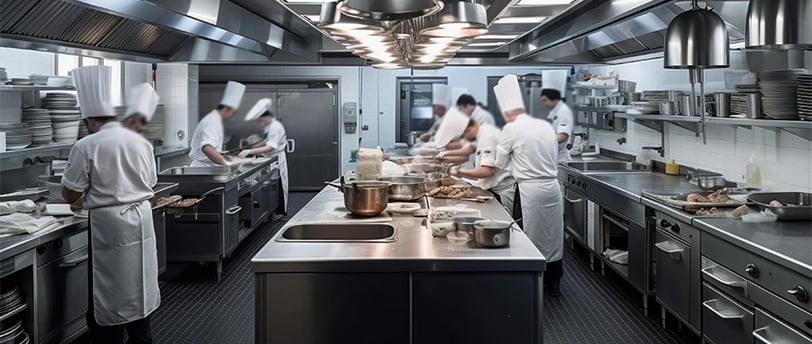Gas Pipeline Installation for Commercial Kitchens
In the fast-paced environment of a commercial kitchen, reliable gas supply is crucial for maintaining efficiency and safety. Gas pipeline installation is a preferred solution for commercial kitchens, offering a seamless and cost-effective energy source. However, the process demands careful planning and professional expertise to meet the unique challenges of a commercial setup. In this blog, we’ll explore the benefits, considerations, and best practices for gas pipeline installation in commercial kitchens.
PRIME GAS PIPELINE
11/29/20242 min read


Why Gas Pipeline Installation is Ideal for Commercial Kitchens
Uninterrupted Gas Supply
Piped gas systems provide a continuous supply, eliminating the downtime associated with changing gas cylinders.Cost Efficiency
Gas pipelines reduce operating costs in the long term by offering steady gas pressure and eliminating delivery charges for cylinders.Safety Features
Professional installations include advanced safety mechanisms such as shut-off valves and leak detectors, reducing the risk of accidents.Space Optimization
Removing bulky gas cylinders frees up valuable kitchen space, improving workflow and storage options.Eco-Friendly Option
Piped gas systems promote cleaner energy use, reducing the carbon footprint of your kitchen.
Key Considerations for Gas Pipeline Installation in Commercial Kitchens
1. Compliance with Regulations
Commercial kitchens must adhere to strict safety codes and regulations for gas pipeline installations.
Ensure the installation meets local fire safety and health department standards.
Obtain necessary permits from local authorities.
2. High-Quality Materials
Using durable, corrosion-resistant materials ensures the system can withstand the demands of a busy kitchen environment.
Stainless steel or flexible piping is ideal for longevity and safety.
All fittings and connections should meet industry standards.
3. Proper System Design
A well-designed gas pipeline system ensures efficient gas flow to multiple appliances simultaneously.
Assess the kitchen layout to optimize the placement of pipelines and connections.
Install individual shut-off valves for each appliance for better control and safety.
4. Safety Measures
Given the high-risk nature of gas systems, implementing safety measures is essential.
Include leak detection systems and emergency shut-off mechanisms.
Regular maintenance checks are critical to identify and address issues early.
5. Energy Efficiency
Energy efficiency is a top priority in commercial kitchens to reduce operating costs.
Use energy-efficient appliances that are compatible with the gas pipeline system.
Ensure proper insulation to minimize energy loss.
Steps in Gas Pipeline Installation for Commercial Kitchens
Initial Assessment
Professionals assess the kitchen layout, appliance requirements, and gas supply options.System Design
A customized pipeline layout is created to ensure efficient gas distribution.Installation
Trained technicians install the pipelines, connectors, and safety devices using high-quality materials and tools.Testing and Certification
The system undergoes rigorous testing for leaks, pressure stability, and compliance with safety standards.Handover and Training
The provider educates the kitchen staff about operating and maintaining the system safely.
Common Challenges in Commercial Kitchen Gas Pipeline Installations
Space Constraints
Limited space requires innovative pipeline designs to ensure smooth operations without hindering workflow.
High Appliance Demand
Commercial kitchens often use multiple high-demand appliances simultaneously, requiring careful pressure regulation.
Frequent Usage Wear and Tear
Constant use can lead to wear, making regular maintenance essential to prevent breakdowns.
Benefits of Professional Gas Pipeline Installation
Customized Solutions: Tailored designs to meet the unique needs of your kitchen.
Enhanced Safety: Adherence to safety protocols reduces the risk of accidents.
Reliable Performance: Ensures consistent gas supply, even during peak hours.
Long-Term Savings: Reduces energy costs and maintenance expenses over time.
Conclusion
Gas pipeline installation is a game-changer for commercial kitchens, enhancing safety, efficiency, and reliability. However, the process requires careful planning and expert execution to meet the unique demands of a busy kitchen.
By hiring certified professionals and focusing on high-quality materials, customized designs, and regular maintenance, you can ensure that your kitchen operates smoothly and safely.
Ready to upgrade your commercial kitchen with a gas pipeline installation? Contact a licensed service provider today for a seamless and hassle-free experience.
Prime Gas Pipeline Installation Services in Hyderabad
Best gas pipeline installation service in Hyderabad Secunderbad ensuring safety.
Contact Us Now
PrimeGasline28@gmail.com
+91 9666106900
© 2024 Prime Gas Pipeline Service. All Rights Reserved
Our Services
Gas Pipeline Installation
Gas Pipeline Repairs
Gas Appliance Service
Prime Gas Pipeline Service is dedicated to providing superior gas pipeline installation solutions efficiency. Serving residential properties with expertise and precision, we ensure that every project is completed to the absolute satisfaction of all our clients.
Our Gas Pipeline Installation Service Locations In Hyderabad & Secunderabad
Gas Pipeline fitting In Hyderabad & Secunderabad, Gas Pipeline fitting In Pragathi Nagar, Gas Pipeline fitting In Bachupally, Gas Pipeline fitting In KPHB, Gas Pipeline fitting In Panjagutta, Gas Pipeline fitting In Ameerpet, Gas Pipeline fitting In Sai Nagar, Gas Pipeline fitting in Moosapet, Gas Pipeline fitting In Kukatpally, Gas Pipeline fitting In Nizampet, Gas Pipeline fitting In Miyapur, Gas Pipeline fitting In Lingampally, Gas Pipeline fitting In Patancheru, Gas Pipeline fitting In Secunderabad, Gas Pipeline fitting In Banjarahills, Gas Pipeline fitting In Jubilee Hills, Gas Pipeline fitting In Madhapur, Gas Pipeline fitting In Hitech City, Gas Pipeline fitting In Kondapur, Gas Pipeline fitting In Gachibowli, Gas Pipeline fitting In Nallagandla, Gas Pipeline fitting In Tellapur, Gas Pipeline fitting In Manikonda, Gas Pipeline fitting In Chintal, Gas Pipeline fitting In Jeedimetla, Gas Pipeline fitting In Alwal, Gas Pipeline fitting In Malkajgiri, Gas Pipeline fitting In Sainikpuri, Gas Pipeline fitting In Ecil, Gas Pipeline fitting In Tarnaka, Gas Pipeline fitting In Uppal, Gas Pipeline fitting In LB Nagar, Gas Pipeline fitting In Dilsukhnagar.
